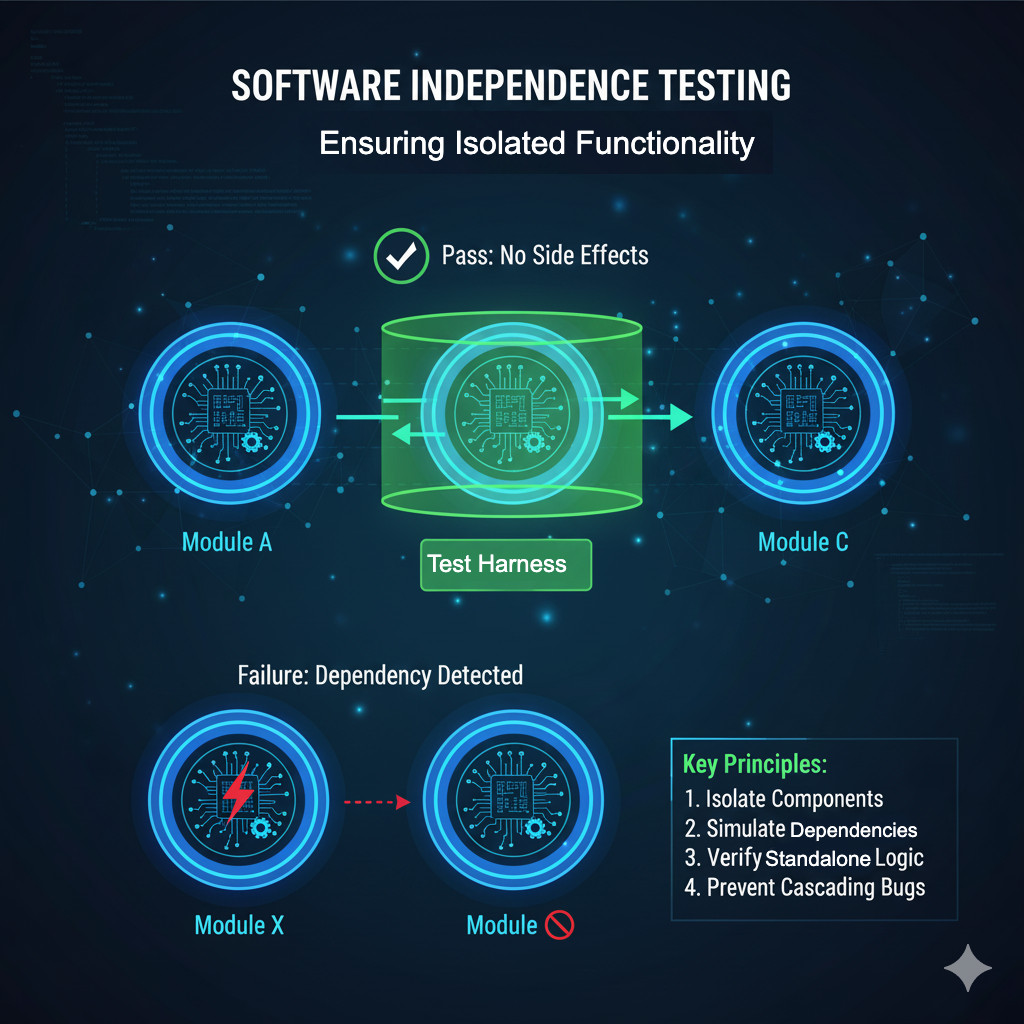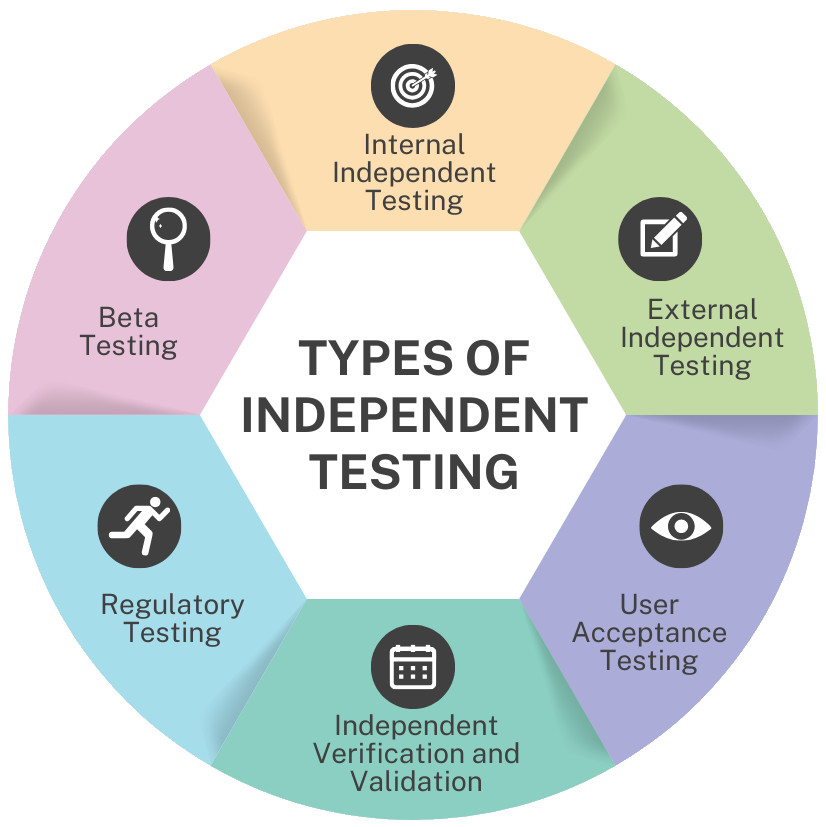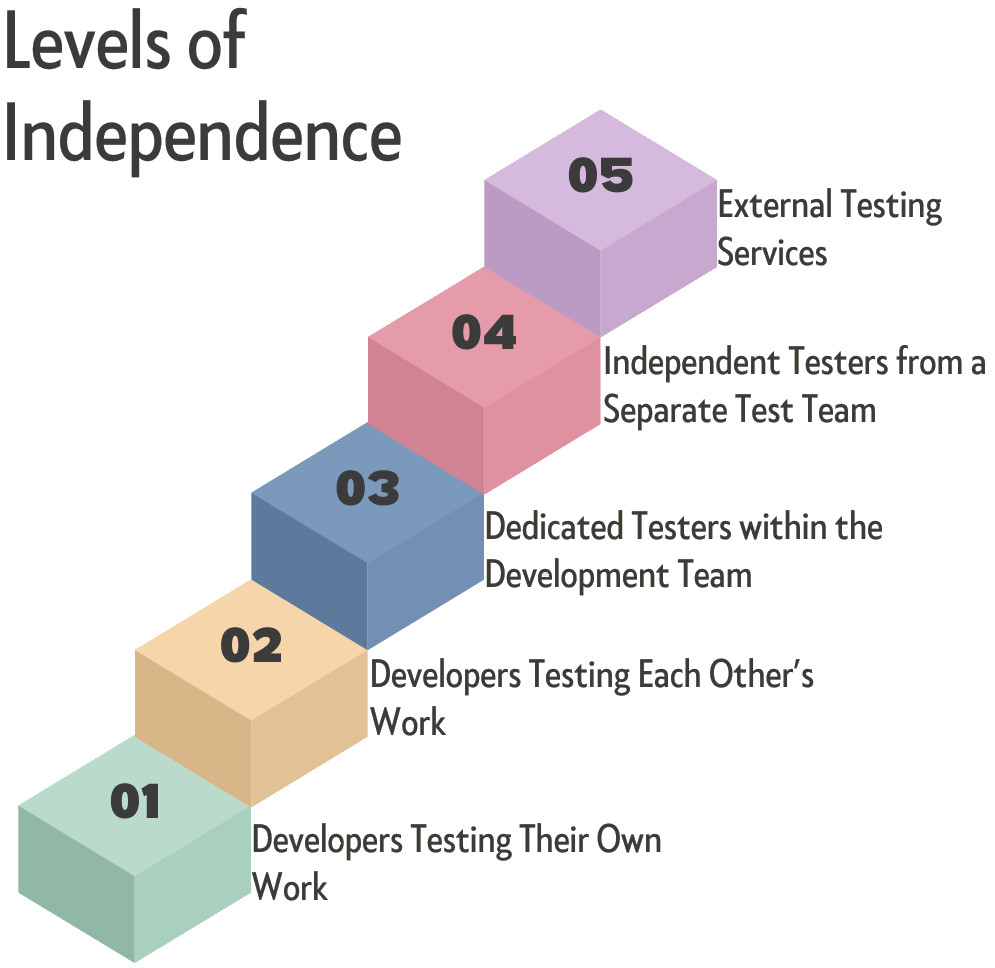Independent Testing: The Key to Product Quality Assurance
|
|
Independence is the ability to choose your own path.
Today, quality, reliability, and security of applications are more important than ever. As software systems grow more complex and more and more part of business processes, even small bugs can cause huge financial losses, reputational damage, or even safety risks. Although developers work to create error-free code, they can practically not identify all possible problems because of familiarity bias, workload pressures, and the complexity of software systems. This is where independent testing is involved.

Independent testing is the process of software being tested by people or groups that are not directly engaged in the development of the software. The separation of the functions of development and testing allows organizations to obtain a more objective and unbiased assessment of software quality. Independent testing is becoming a best practice in sectors where software reliability is of utmost importance, including finance, healthcare, transportation, and critical infrastructure.
| Key Takeaways: |
|---|
|
Independent Testing: Definition
Independent testing is the process of performing verification or validation testing by individuals or teams who are not directly involved in the development of a product, to enhance software quality. The primary goal of independent testing is to provide an impartial and unbiased assessment of the software performance, security, features, etc., against its requirements. Unlike in the practice of developer testing, where often their focus is on testing the code that they have written, independent testers approach their software and test it objectively, attempting to uncover defects, weaknesses, or inconsistencies that were overlooked in development.
Core Principles of Independent Testing
- Separation of Duties: The individuals who develop the software should not be the only ones validating it.
- Objective Assessment: Testing must be free from bias caused by knowledge of design shortcuts, code intricacies, or developer assumptions.
- Focus on Requirements: Independent testing emphasizes whether the product meets stated requirements and user expectations.
- Traceability: Tests should be linked back to requirements, ensuring every requirement is validated independently.
- Risk-Based Testing: Independent testers can evaluate software risks impartially, prioritizing critical areas.
Why Independence Testing Matters
Testing independence is an important factor in the reliability and security of software systems as well as their general quality. The fact that they have independent testers means there are fresh eyes to catch things the developers wouldn’t. Developers can be too close to the code, and they may unconsciously assume that their software is working or overlook small bugs. One method of overcoming this cognitive bias is through independent testing, allowing for an outward and unbiased perspective.
- Objective Evaluation of Software: Independent testers are not affected by developers’ design choices or assumptions. This objectivity makes sure that the software is judged based on its real behaviour rather than what the developers want it to perform.
- Identification of Hidden or Subtle Defects: Independent testers look at software as an external user or system, and this is what assists in identifying defects that might not be visible in normal conditions, complex interactions, or infrequent usage situations.
- Improved Risk Management: Independent testing provides an additional level of scrutiny, particularly in critical systems where failure may have serious financial, operational or safety consequences. Early risk identification helps organizations to reduce possible issues before they become serious. Read: Technology Risk Management: A Leader’s Guide.
- Enhanced Credibility and Stakeholder Confidence: Clients, regulators, and end-users tend to trust software that has been verified by an independent team. It shows that the product has been through a strict, objective quality assurance process, which enhances trust in its performance and reliability.
- Promotion of Best Practices: Independent testing helps developers to be more careful in adhering to coding standards, documentation practices, and testing protocols because they are aware that their work will be reviewed by another party. This tends to enhance general software discipline and quality.
Types of Independent Testing

There are various types of independent testing depending on the person who does the testing and the level of independence of the development team. Both types have their own benefits and can be used at various software lifecycle phases. Knowledge of these types assists organizations in selecting the best testing strategy to guarantee the quality and reliability of software.
Internal Independent Testing
Internal independent testing is conducted by people other than the software developers within the same organization. This provides a sort of bias neutrality as the testers are not involved in coding activities. It’s a common choice for Agile and DevOps teams, because it enables testers to work in tandem with developers but remain impartial. For example, a QA member of the sprint team can verify some features developed by other team members to exclude bias.
For instance, in Agile teams, tools like testRigor enable internal independent testers to build end-to-end tests without coding. This ensures quick, unbiased validation while staying in sync with the sprint cycle.
External Independent Testing
External independent testing is performed by a group that is external to the organization, e.g., an outsourced company, a third party or an independent software testing organization with its own infrastructure. This one is the most independent since they are testers who work independently from the development or business team. It is great, especially for neutral reviews, conformity assessment, and security verification. An applied example would be the penetration test by a cybersecurity company.
User Acceptance Testing (UAT)
The UAT is performed by business users or end-users, since no credit was given to this requirement during the development phase. The aim is to validate if the system meets business needs and is usable in practice. UAT ensures that the product is in compliance with users views and business purposes prior to release. For example, a retail worker may try out an e-commerce checkout experience to verify that it works well for customers. Read about User Acceptance Testing: Manual vs. Automated Approaches.
Independent Verification and Validation (IV&V)
Independent Verification and Validation (IV&V) is a formal process in which an independent body tests the product, verifying if the software satisfies specified requirements (verification) and if it represents or fulfills its intended use (validation). This is sometimes required in safety-critical industries, such as defense, aerospace or healthcare. The software testing organization’s independence affords it an element of objectivity in testing the product, too. This investigation depth mitigates risks on mission-critical applications. Read more – Verification and Validation in Software Testing: Key Differences.
Regulatory Testing
Regulatory tests are typically done in order to meet industry or government standards. In most cases, independent accredited laboratories conduct this testing. It is important in industries such as health care, finance and aviation where legal or safety requirements are stringent. FDA, for instance, requires independent validation of healthcare software to ensure patient safety and compliance.
Beta Testing
In beta testing, tests are performed by users who do not possess the developer’s abilities and knowledge under normal, non-developer/laboratory conditions. As these testers were all true end users or solicited representatives of the target user pool, they can give feedback from actual use. This type of manual testing can help you discover usability issues, performance degradation, and strange behavior. For instance, a tech company may roll out a beta version of an app to get users’ feedback ahead of its formal launch. Read about Alpha vs. Beta Testing: A Comprehensive Guide.
Independent Testing vs. Developer Testing
| Feature / Aspect | Developer Testing | Independent Testing |
|---|---|---|
| Definition | Testing is performed by the developers who wrote the code. | Testing performed by a separate individual/team not involved in development. |
| Independence Level | Low; developers may have biases toward their own code. | High; testers are unbiased and objective. |
| Primary Focus | Ensuring the code works as intended, catching syntax or logical errors early. | Identifying defects from a user/system perspective, including hidden or unexpected issues. |
| Expertise | Developers understand the code and design deeply. | Testers specialize in QA, testing techniques, and defect identification. |
| Defect Detection | May miss errors due to assumptions or familiarity with the code. | More likely to catch overlooked, subtle, or non-obvious defects. |
| Feedback Timing | Immediate; testing is integrated into development. | May take longer, as testing is performed after development or in parallel. |
| Cost | Usually lower since it doesn’t require additional resources. | Higher due to dedicated testers or external teams. |
| Bias Risk | High; developers may unconsciously avoid testing scenarios that could reveal their mistakes. | Low; independent testers have no attachment to the code. |
| Use Cases | Unit testing, code validation, and early bug fixes. | System testing, integration testing, acceptance testing, and critical systems validation. |
Levels of Independence Testing
The level of autonomy in the test also largely depends upon the organization’s structure, development setup and complexity of the project. This independence is defined at different levels by the International Software Testing Qualifications Board (ISTQB) with its associated benefits and drawbacks.

Level 1: Developers Testing Their Own Work (Lowest Independence)
When developers test their own work, the same person who wrote the code also performs the testing. This approach offers immediate feedback and leverages the developer’s deep understanding of the codebase. However, it carries a high risk of bias, as developers may overlook issues due to their familiarity with the implementation. It is most commonly used for unit testing and resolving early-stage defects.
Level 2: Developers Testing Each Other’s Work (Peer Testing)
In peer testing, developers review and test the code created by their teammates. This method introduces more objectivity than self-testing while also encouraging knowledge sharing within the team. However, independence is still limited since peers may share similar assumptions and miss the same types of errors. It is often applied during code reviews and integration testing.
Level 3: Dedicated Testers within the Development Team
With dedicated testers embedded in the development team, testing is handled by specialists rather than the code authors. This setup brings deeper testing expertise and a more objective view of software quality. However, testers may still be influenced by team priorities, leading to some organizational bias. This model is typically applied to system and integration testing during the development cycle.
Level 4: Independent Testers from a Separate Test Team
When testing is carried out by an independent team separate from development, it ensures a high level of objectivity. These testers focus solely on quality, making defect detection more unbiased and reliable. The tradeoff is the need for extra coordination with developers, which can slow feedback. This approach is commonly used for system, acceptance, and regression testing in critical applications.
Level 5: External Testing Services (Highest Independence)
External testing services involve outsourcing quality assurance to a third-party organization. This provides the highest level of independence, with objective assessments and access to specialized tools and broad expertise from working on diverse projects. However, it can be costly and may lead to communication challenges or limited understanding of the product’s domain. Such services are often used for compliance checks, critical system validations, and security testing.
Comparative Analysis of Independence Levels
- Low Independence (Levels 1 & 2): Faster turnaround but risks biased results.
- Medium Independence (Level 3): Balanced objectivity and collaboration, ideal for Agile teams.
- High Independence (Levels 4 & 5): Best for critical, high-risk, or compliance-heavy domains where quality cannot be compromised.
Benefits of Independent Testing
- Unbiased Defect Detection: Independent testers offer an objective viewpoint, pointing out flaws, bugs, or vulnerabilities that developers may not notice because they are familiar with the code.
- Higher Confidence in Quality: Neutral evaluation guarantees that the stakeholders are able to trust the reliability, performance, and compliance of the software.
- Specialization and Expertise: Independent testers are usually experts in specific fields like security, performance, usability, or regulatory compliance, which makes them test in a comprehensive and professional manner.
- Risk Reduction: Early detection of defects and vulnerabilities minimizes the risk of costly post-release failures and operational disruptions.
- User Advocacy: Independent testers look at the software as an end-user, making sure that it is usable, accessible, and meets the expectations of the user. With testRigor, independent testers and even business users can write tests in natural language that mimic real user behavior. This ensures that testing closely reflects actual end-user interactions, leading to better usability validation and stronger user advocacy.
Understand how to Decrease Test Maintenance Time by 99.5% with testRigor.
Risks of Independent Testing
- Communication Barriers: Independent testers can have difficulties in interpreting requirements or design intent, and thus misunderstand functionality or anticipated behaviour.
- Slower Feedback Loop: Usually performed independently of development, so defect reporting and resolution may be delayed, which may slow down project schedules.
- Increased Project Costs: Adds additional cost to the project when compared to developer-led testing.
- Over-Reliance on Independence: Using independent testers alone can diminish the sense of ownership and responsibility for quality and defect detection in their own work by developers.
- Limited Domain Knowledge: Independent testers might not be well versed in the particular business or technical area and this can lead to the failure to detect context-specific defects or functionality nuances.
Conclusion
Independent testing is crucial to the quality of software as it offers an unbiased standpoint devoid of any development aspects. It can support early discovery of hidden bugs, improve stakeholders confidence in the system under test and reduce risks on defense-critical applications. The process is improved through the use of tools like testRigor, which permit independent teams and even business users to write tests in plain English with automatic code generation, meaning minimal maintenance burden and wider test coverage.
Balancing independence with collaboration helps organizations achieve reliable, scalable, and efficient testing results.
| Achieve More Than 90% Test Automation | |
| Step by Step Walkthroughs and Help | |
| 14 Day Free Trial, Cancel Anytime |












